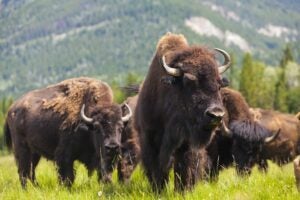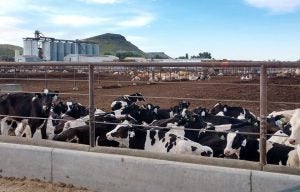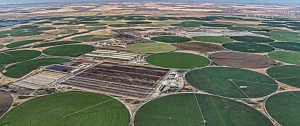Cows and methane. No doubt you have heard that cow’s burps are a major source of methane, a very active greenhouse gas. Sources vary, but some say ruminants, of which cows are just one example, are responsible for 16 percent of worldwide methane emissions.
What are ruminants? Ruminants have a specialized stomach, called the rumen, that harbors bacteria and other organisms that ferment grasses and other vegetative food, turning otherwise indigestible fiber into compounds the ruminant can use for growth and maintenance. But one class of organisms, the methanogens, working in the oxygen deficient environment of the rumen, use some of those products of fermentation for their growth and maintenance, releasing methane as a byproduct. The ruminant burps this methane into the atmosphere.
But here is something you have probably never heard when cows are accused of being a major cause of global warming: Methane contains one carbon atom and four hydrogen atoms. The carbon atom a ruminant belches came from the carbon dioxide a plant took from the atmosphere. The methane released from the rumen will decay back to carbon dioxide after 10 to 12 years of roaming around the atmosphere.
This cycle has been going on for thousands of years as the ruminant family, which includes cattle for meat and milk, cattle for draft work, sheep, goats, elk, deer, antelope, bison, wildebeests, giraffes, etc., grazed the Earth’s grasslands and burped methane. Considering the large herds of bison (60 million to 100 million) and other grazers that existed before humans replaced most of them with cattle, one can assume the methane in the atmosphere from ruminants of all types has not changed much in tens of thousands of years.

Something you have no doubt heard is that cattle who live their entire lives on pastures (i.e. grass-fed beef) emit less methane. That’s not true.
Digesting pasture grasses and legumes requires robust microflora communities in the rumen (first of four stomachs) to breakdown the lignin and other complex carbohydrates that give growing plants strength to stand upright and withstand the vagaries of the environment: wind, drought, floods, insects, diseases. They can’t run, they have to defend themselves in place. Seeds of these plants, on the other hand, are rich in easy-to-digest fats, oils, and starches for quick and easy energy to give plants a good chance to survive the vulnerable first few weeks of life. Seeds of grains and legumes are especially good animal (and human) food.
So when a ruminant is fed grain, methanogens are suppressed and less methane is produced. The animal converts more of its feed to growth and maintenance. That’s why cattle in feedlots put on gain much faster and more efficiently than grass-fed beef. It takes two to three years to bring a pastured beef animal to slaughter condition. Feedlot beef spend a year on pasture and six months on a ration high in grains.
The time from birth to slaughter alone means less methane is produced from grain-fed beef, plus the fact that rations are high in grains result in less methane burps.

Critics say, “Grass is the natural food for cattle, not grain.” Again, not entirely true. Grain is like candy to cattle. If she (or he) breaks into the granary, they will eat until very sick, or even kill themselves. Grain is high-energy food — it must be mixed with forage.
Regardless, much is being done to mitigate methane emissions from cows. Research on feed additives that will suppress methanogens has been going on for years. In July of 2020, Burger King introduced a “reduced methane” burger in selected markets, claiming they had achieved methane reductions of 33 percent by adding small amounts of lemongrass (high in citronella oil) to the feedlot ration. Since lemongrass is only fed in the feedlot, scientists say the lifetime reduction is only three percent.
Research has shown that feedlot methane reductions of 50 percent can be achieved by adding nitrates to the ration, but dosage between safety and toxicity is narrow. One class of compounds that have proven safe and effective are ionophores, compounds that inhibit the transport of ions across cell walls. They do not kill bacteria or archaea, but do suppress their growth and reproduction. These compounds are therefore classified as antibiotics but are not an antibiotic used in human medicine and are not regulated under the Veterinary Feed Directive that limits antibiotic use. The ionophore monensin is routinely used in beef production and can result in a feed-to-weight efficiency gain of 7 to 10 percent, with a corresponding reduction in methane production.
Cattle’s methane impact in the U. S. is significantly less than 50 years ago and continues to reduce because of efficiency gains in producing beef and milk. In 1970, 12.5 million milk cows produced 117.4 million pounds of milk. In 2019, 9.3 million cows produced 218.4 million pounds — 86 percent more milk from 26 percent less cows. Just since January 2000, milk production per cow has risen 28 percent and the dairy industry now produces 30 percent more milk on just slightly more cows.
Beef cattle numbers are down 6 percent since 1970, but meat production from those cattle is up 25 percent, partly due to heavier weight at slaughter, made possible by breeding animals to deliver higher growth rates and higher feed efficiencies. Expect these efficiency trends to continue.
Also expect methane emissions from manure lagoons at large dairies to continually drop as more owners cover their lagoons and utilize the methane produced.
Threemile Canyon Farms at Boardman, Oregon, one of the largest dairies in the U.S. (35,000 milking cows and 70,000 total cattle), recently upgraded their methane digester installed in 2012. The digester supplies three electrical generators that can produce a total of 4.8 megawatts. (A typical windmill can produce 2.5-3 megawatts, an average Snake River dam — 1000 megawatts.) The $30 million update converts the methane to renewable natural gas which can be pumped into natural gas lines leading to homes and businesses.

The leftover solids from the digester provides nutrients for much of the farm’s 39,500 acres of organic and non-organic crops. It’s a closed-loop system: Cows eat, they poop, the poop is collected in a covered lagoon, microorganisms digest it and emit methane, the methane is burned to produce electricity, and the solids leftover feed the crops that feed the cows.
Welcome to the future, pioneered by responsible agriculture.
Worldwide, the biggest source of carbon dioxide is the fossil fuel industry — oil, natural gas, and coal. Ruminants are said to account for 16 percent of emissions, but as I said in the beginning, this methane was built from carbon dioxide currently present in the atmosphere, and will decay back to carbon dioxide in 10 to 12 years. Sewage treatment and animal waste each contribute 5 percent. Termites emit 4 percent. Rice cultivation accounts for 12 percent, as methanogens do well in waterlogged soils, where oxygen levels are suppressed. Landfills and biomass burning account for 14 percent. Wetlands and other natural sources amount to 25 percent.
The world is estimated to contain 1.5 billion cattle. Adding wild ruminants would bring total ruminate numbers to 2 billion or so, all belching methane. Some people want to eliminate 1 billion cattle and covert people to veganism. But humans pass methane too, and a vegan diet doubles the amount. And there are 8 billion of us. Maybe getting all our protein from beans and peas would be a zero sum change? (Just kidding.)
In October 2022, the Congressional Research Service assigned 11 percent of U. S. greenhouse gas emissions to agriculture and forestry, and credits these industries — which sink vast amounts of atmospheric carbon into soil and plant tissue — with offsetting 13 percent of total U. S. greenhouse gas emissions, a net positive of 2 percent for these industries. So please, DON’T BLAME THE COWS!
Jack DeWitt is a farmer-agronomist with farming experience that spans the decades since the end of horse farming to the age of GPS and precision farming. He recounts all and predicts how we can have a future world with abundant food in his book “World Food Unlimited.” A version of this article was republished from Agri-Times Northwest with permission.



